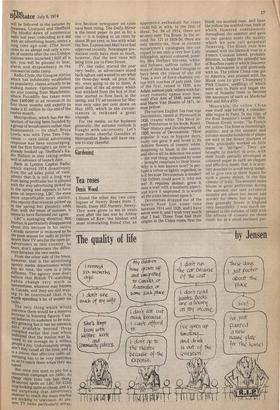Gardening
Tea roses
Denis Wood
I found the other day two catalogues of Newry Roses from T. Smith, Daisy Hill Nursery, Newry. They were given to me in years soon after the last war by Arthur Osborn of Kew, the kindest and most stimulating friend that an
apprentice enthusiast for roses could fall in with In the first of these, No. 94 of 1914, there are seventy-nine Tea Roses. In the second, No. 121 of 1929-30, there are only twenty-six. Now in current nurserymen's catalogues one can expect to see only a very few: Lady Hillingdon, apricot coloured, possibly ' Mrs Herbert Stevens, white, and Safrano, saffron colour. But none of these has what I imagine to have been the colour of the old Teas, a sort of fawn-chainoix yellow with touches of pale pink. One of the first, raised in 1838, was Adam, salmon pink; others with faraway romantic names were Sou-. venir d'un Ami of 1846, pale rose, and Marie Van Houtte of 1871, lemon yellow. The earliest English Tea rose was Devoniensis, raised at Plymouth in 1838, creamy white. The Revd Joseph Pemberton in his book, Roses, Their History and Development, of 1920, wrote of Devoniensis: "How popular it was in bygone days, every one grew it and loved it; its delicate flowers of creamy white, deepening to blush in the centre, and above all its delicious tea scent — the real thing, surpassed by none — brought rosarians to their knees. Why is it less known now? Is perfume a virtue so lightly regarded, or is it because Devoniensis is tender? Our fathers could grow it, why not we? It requires shelter; grow it near a wall with a southern aspect, and leave it unpruned. It is worth all the pains bestowed upon it."
Devoniensis dropped out of the Newry Rose List some time between 1914 and 1929, and I have never seen it, and I wish very much that I had. These Teas had their origins in the China roses, first the
blush tea-scented rose, and later the yellow tea-scented rose, both of which flowered continuously throughout the summer and gave to our garden roses the quality which we now call perpetual flowering. The Blush rose was crossed with the Damask rose in a French Colonial Island, probably Reunion, to begin the splendid line of Bourbon roses of which Souvenir de la Malmaison is still gloriously with us. The yellow China rose got to America, was crossed with the Musk rose to give Champney's Pink Cluster, seedlings of which were sent to Paris and began the race of Noisette roses to become the ancestors of such as Marechal Niel and Rave d'Or.
Meanwhile, the yellow China rose itself was having a considerable vogue in Paris. In my copy of the Rose Amateur's Ciutae of 1854, Thomas Rivers wrote: "In France the yellow Tea Rose is exceedingly popular, and in the summer and autumn months hundreds of plants are sold in the flower markets of Paris, principally worked on little stems or 'rni-tiges'. They are brought to market in pots, with their heads partially enveloped in coloured paper in such an elegant and effective mode, that it is scarcely possible to avoid being tempted to give two or three francs for such a pretty object. In the fine climate of Italy, Tea-scented roses bloom in great perfection during the autumn: our late autumnal months are often too moist and stormy for them; but in August they generally flower in England very beautifully. I was much impressed in the autumn of 1835 with the effects of climate on these roses; for in a small enclosed gar
den at Versailles, I saw, in September, hundreds of plants of yellow Tea Roses covered with ripe seeds and flowers."
The inter-crossing of Blush China, Yellow China and Bourborr resulted in the race of Tea roses which, although never really hardy in Britain, were greatly loved in Victorian times by those who lived in the south and could give them warm positions or grow them in pots in a conservatory.
The Good Life



































 Previous page
Previous page